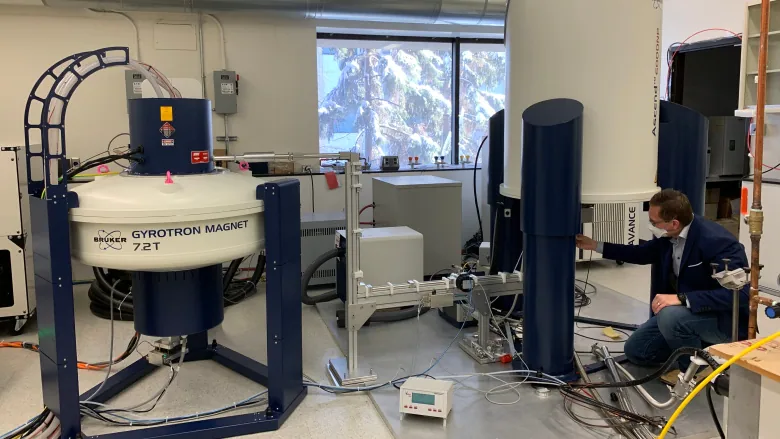University of Alberta research equipment at risk of damage due to a global helium shortage has been saved — at least in the short-term. Helium top-up ensures equipment won't go offline, facility manager says Stephen Cook · CBC News · Posted: May 23, 2022 8:00 AM MT | Last Updated: May 23 Chemistry professor [...]
Helium top-up ensures equipment won’t go offline, facility manager says
Stephen Cook · CBC News · Posted: May 23, 2022 8:00 AM MT | Last Updated: May 23

Chemistry professor Vlad Michaelis, shown here, inspects instruments with superconducting magnets at the University of Alberta. (Julia Wong/CBC)
University of Alberta research equipment at risk of damage due to a global helium shortage has been saved — at least in the short-term.
Liquid helium is needed to keep superconducting magnets in instruments, such as mass spectrometers and MRI machines, at extremely low temperatures.
Ryan McKay, a facility manager in charge of the specialized equipment, said the university was expecting to only get about 75 per cent of the needed supply this year.
“Superconducting magnets don’t operate that way,” he said. “We need constant supplies.”
A few months ago, McKay started looking far afield for solutions. He connected with Calgary-based North American Helium.
The company has stepped up to help keep the helium flowing to around 20 Canadian educational research institutions, with a volume equivalent to about three months of supply.
- Video
Helium shortages leave some western Canadian universities scrambling
The company does not have distribution capabilities, said North American Helium president Marlon McDougall, so it has to sell helium directly to distributors with an agreement that it would reach the institutions.
The U of A has more than 20 superconducting magnets, each with an estimated value of $1 million. The aid means the university doesn’t “have to pick which quarter of them die,” McKay said.
“I haven’t even been able to begin to calculate how much infrastructure money has been saved across Canada.”
Need for domestic helium
The situation demonstrates the need for Canada to further develop its domestic helium production from extraction to delivery, McKay said.
Alberta introduced a new royalty structure for helium two years ago, in a bid to buoy exploration and production.
- Sask. government wants province to become world leader in helium production
- Alberta’s new helium royalties could see rise of extraction industry
Saskatchewan is posturing to become a helium production leader. aiming to supply 10 per cent of the global market by 2030.
North American Helium currently operates facilities in Saskatchewan, including a $32-million purification plant in Battle Creek, Sask., which the company says is the largest helium production facility in Canada.

North American Helium’s largest helium production facility is located near Battle Creek, Sask. (Submitted by North American Helium)
As a Canadian corporation, North American Helium was motivated to do what it could, McDougall said.
“This was a problem in Canada and I think solutions in Canada are good things,” he said.
McDougall hopes to expand operations in the near future — but he said there remains “a large shortfall” between supply and demand.
Global shortage
Helium supply is an intricately connected market. The top three producers are the United States, Algeria and Qatar.
The supply chain for helium, as with other commodities, has been an ongoing issue throughout the COVID-19 pandemic, said Phil Kornbluth, president of Kornbluth Helium Consulting.
- Concerns rising over global helium shortage
But 2022 brought more unexpected disruptions, including the shutdown of a major purification plant in Texas over safety issues. The opening of a major facility in Russia was also delayed.
“This year was expected to be a year where the market transitioned from tight supply to more ample supply,” Kornbluth said.
He predicts there could be some relief on the horizon due to several developments, such as decreased demand from Chinese industries under COVID-19 lockdown, and the Texas facility coming back online in the near future.
“Some of the negative things that have caused the shortage should go away,” Kornbluth said.
“Doesn’t mean the shortage ends, but it should be less severe during the second half [of the year].”
Content retrieved from: https://www.cbc.ca/news/canada/edmonton/university-alberta-helium-shortage-1.6458721?__vfz=medium%3Dsharebar.



COMMENTS